Copying is a rather complicated subject requiring very precise knowledge of the rules, as well as, oh gosh! understanding the layer system. Cards like Mimic Vat, Mirrorweave, Phyrexian Metamorph, Isochron Scepter, Essence of the Wild, Stolen Identity regularly cause many questions.
Greetings everyone and welcome to another class of the Judge school. This class will comprise three parts. The first one will be dedicated to copying permanents and cards, in the second one is about copying special cards and in the third part we’ll talk about copying spells and abilities.
Alright, here we are. Each time we see the word “copy” in an effect text, a voice in our head must tell us:
Copiable values
What are those?
For permanents those are name, mana cost, color, card type, subtype, supertype, rules text, power, toughness and loyalty. Basically, it is what’s printed on the card or appeared on it as a result of copying another permanent. This mnemonic rule will be helpful enough in most situations. You do need to remember that some abilities set or change copiable values. Aside from that, an object’s state also influences copiable values.
706.2. When copying an object, the copy acquires the copiable values of the original object’s characteristics and, for an object on the stack, choices made when casting or activating it (mode, targets, the value of X, whether it was kicked, how it will affect multiple targets, and so on). The “copiable values” are the values derived from the text printed on the object (that text being name, mana cost, color indicator, card type, subtype, supertype, rules text, power, toughness, and/or loyalty), as modified by other copy effects, by its face-down status, and by “as… enters the battlefield” and “as… is turned face up” abilities that set power and toughness (and may also set additional characteristics). Other effects (including type-changing and text-changing effects), status, and counters are not copied.
Example: Chimeric Staff is an artifact that reads “{X}: Chimeric Staff becomes an X/X artifact creature until end of turn.” Clone is a creature that reads, “You may have Clone enter the battlefield as a copy of any creature on the battlefield.” After a Staff has become a 5/5 artifact creature, a Clone enters the battlefield as a copy of it. The Clone is an artifact, not a 5/5 artifact creature. (The copy has the Staff’s ability, however, and will become a creature if that ability is activated.)
Example: Clone enters the battlefield as a copy of a face-down Grinning Demon (a creature with Morph {2BB}). The Clone is a colorless 2/2 creature with no name, no types, no abilities, and no mana cost. It will still be face up. Its controller can’t pay {2BB} to turn it face up.
706.2a. A copy acquires the color of the object it’s copying because that value is derived from its mana cost or color indicator. A copy acquires the abilities of the object it’s copying because those values are derived from its rules text. A copy doesn’t wind up with two values of each ability (that is, it doesn’t copy the object’s abilities and its rules text, then have that rules text define a new set of abilities).

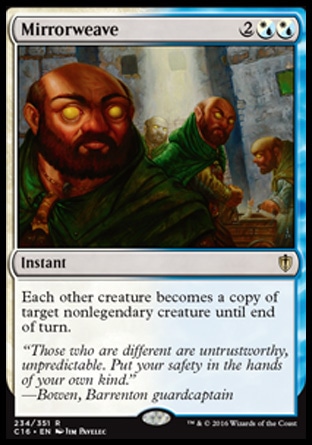
An opponent attacks you with a nasty gang of huge creatures, you animate your Mutavault and cast Mirrorweave, choosing Mutavault as the target. All of your opponent’s creatures become… unanimated Mutavaults! And they leave combat! The type “creature” and power/toughness 2/2 was given to Mutavault by activating its ability which doesn’t affect copiable values!
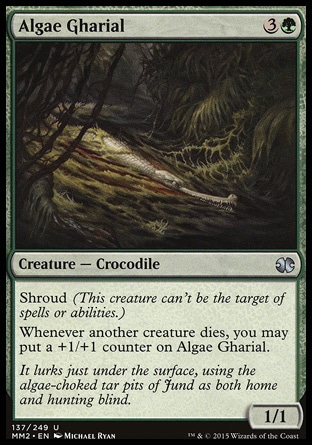
You cast a Phyrexian Metamorph and have it become a copy of Algae Gharial with 5 counters on it. As a result we get… whoops! A crocodile with no counters. No counters are printed on the Gharial, and so they are not copied.


There are cards that have two sets of characteristics: Morphs, manifested cards and other cards turned face down, flip cards and double-faced cards. Read about them in Copy special cards article.
“In and out”
If a permanent becomes a copy of another object, it doesn’t cause EtB-triggers to go off and does not cancel out other effects being applied.
706.4. Some effects cause a permanent that’s copying a permanent to copy a different object while remaining on the battlefield. The change doesn’t trigger enters-the-battlefield or leaves-the-battlefield abilities. This also doesn’t change any noncopy effects presently affecting the permanent.
Example: Unstable Shapeshifter reads, “Whenever a creature enters the battlefield, Unstable Shapeshifter becomes a copy of that creature and gains this ability.” It’s affected by Giant Growth, which reads “Target creature gets +3/+3 until end of turn.” If a creature enters the battlefield later this turn, Unstable Shapeshifter will become a copy of that creature, but it will still get +3/+3 from the Giant Growth.
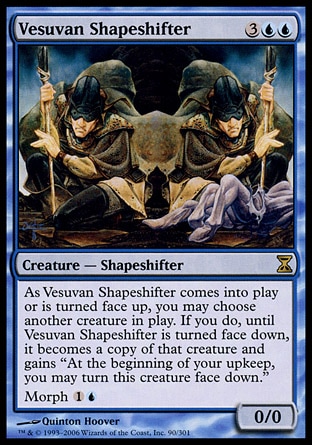

For instance, if we “unmorph” a Vesuvan Shapeshifter and copy a Mulldrifter on the field, we won’t draw cards.


If Overrun is cast, and then your opponent casts Mirrorweave turning all creatures into bears, your bears will still fall under the Overrun effect.
An object that enters the battlefield as a copy of a permanent becomes that permanent in the process of entering it. So there is no moment when it has already entered play, but is not the copy of that permanent yet. This immediately means that EtB-triggers do go off, and the replacement effects inherent to the original are applied to the copy.
706.5. An object that enters the battlefield “as a copy” or “that’s a copy” of another object becomes a copy as it enters the battlefield. It doesn’t enter the battlefield, and then become a copy of that permanent. If the text that’s being copied includes any abilities that replace the enters-the-battlefield event (such as “enters the battlefield with” or “as [this] enters the battlefield” abilities), those abilities will take effect. Also, any enters-the-battlefield triggered abilities of the copy will have a chance to trigger.
Example: Skyshroud Behemoth reads, “Fading 2 (This creature enters the battlefield with two fade counters on it. At the beginning of your upkeep, remove a fade counter from it. If you can’t, sacrifice it.)” and “Skyshroud Behemoth enters the battlefield tapped.” A Clone that enters the battlefield as a copy of a Skyshroud Behemoth will also enter the battlefield tapped with two fade counters on it.
Example: Wall of Omens reads, “When Wall of Omens enters the battlefield, draw a card.” A Clone enters the battlefield as a copy of Wall of Omens. The Clone has the Wall’s enters-the-battlefield triggered ability, so the Clone’s controller draws a card.


For instance, as Vesuvan Shapeshifter enters the battlefield we copy a Mulldrifter in play, and the Shapeshifter enter the battlefield as Mulldrifter, so the trigger goes off. When it resolves, we draw two cards. Compare this to the previous example with “unmorphing”.
Replacement effects that modify the way a creature enters the battlefield are applied in the following order: first the control-changing effects, then copying effects, then all other effects:
616.1e
Example: Essence of the Wild reads: “Creatures you control enter the battlefield as a copy of Essence of the Wild.” A player who controls Essence of the Wild casts Rusted Sentinel, which normally enters the battlefield tapped. As it enters the battlefield, the copy effect from Essence of the Wild is applied first. As a result, it no longer has the ability that causes it to enter the battlefield tapped. Rusted Sentinel will enter the battlefield as an untapped copy of Essence of the Wild.
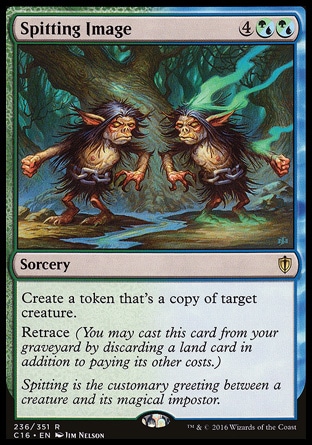
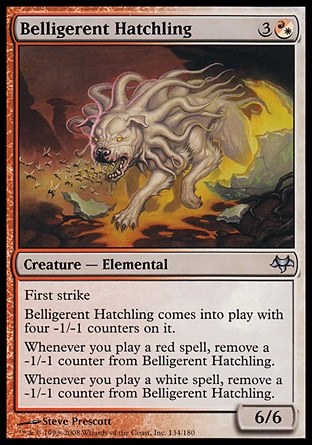
You target Belligerent Hatchling while casting Spitting Image. As a result, we get a token with Belligerent Hatchling characteristics and 4 counters on it.
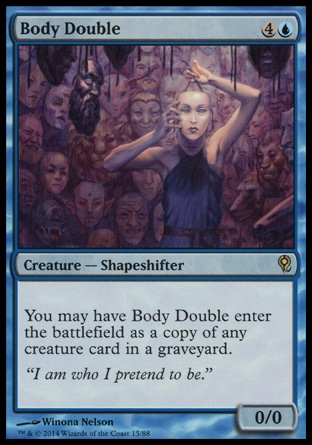
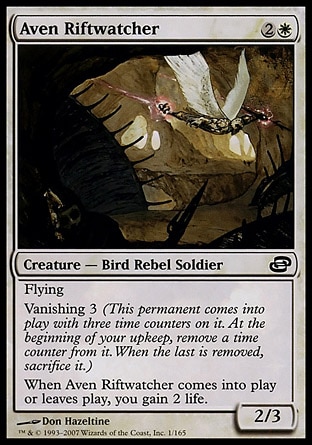
Body Double enters the battlefield as a copy of Aven Riftwatcher. The bird will enter the field with 3 counters because it is dictated that way by the replacement effect of the static part of the keyword ability Vanishing.
“Time to Choose”
When copying permanents, the choices made as the original was entering the battlefield are not preserved. Those values are chosen anew, or are considered undefined, depending on when the copying occurs.
706.6. When copying a permanent, any choices that have been made for that permanent aren’t copied. Instead, if an object enters the battlefield as a copy of another permanent, the object’s controller will get to make any “as [this] enters the battlefield” choices for it.
Example: A Clone enters the battlefield as a copy of Adaptive Automaton. Adaptive Automaton reads, in part, “As Adaptive Automaton enters the battlefield, choose a creature type.” The Clone won’t copy the creature type choice of the Automaton; rather, the controller of the Clone will get to make a new choice.
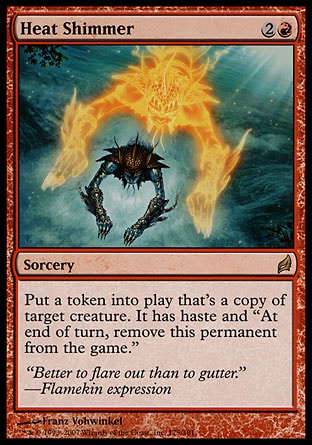
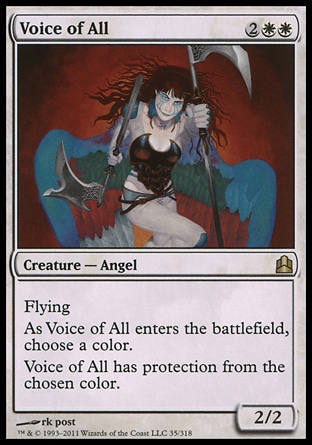
You cast Heat Shimmer, choosing Voice of All as the target; white had been chosen for Voice of All. As the Angel token enters the battlefield, you will be able to choose a color for it. It will have Protection from that color.
If we deal with linked abilities, we need to keep in mind that any choice made by one ability (a chosen value or named card) will only be related to the linked ability. If the object copies another ability that requires a similar choice, the choice will be undefined and the part of such ability that depends on that choice will not have effect.
706.7. If a pair of linked abilities are copied, those abilities will be similarly linked to one another on the object that copied them. One ability refers only to actions that were taken or objects that were affected by the other. They can’t be linked to any other ability, regardless of what other abilities the copy may currently have or may have had in the past. See rule 607, “Linked Abilities.”
706.7a. If an ability causes a player to “choose a [value]” or “name a card,” and a second, linked ability refers to that choice, the second ability is the only ability that can refer to that choice. An object doesn’t “remember” that choice and use it for other abilities it may copy later. If an object copies an ability that refers to a choice, but either (a) doesn’t copy that ability’s linked ability or (b) does copy the linked ability but no choice is made for it, then the choice is considered to be “undefined.” If an ability refers to an undefined choice, that part of the ability won’t do anything.
Example: Voice of All enters the battlefield and Unstable Shapeshifter copies it. Voice of All reads, in part, “As Voice of All enters the battlefield, choose a color.” and “Voice of All has protection from the chosen color.” Unstable Shapeshifter never had a chance for a color to be chosen for it, because it didn’t enter the battlefield as a Voice of All card, so the protection ability doesn’t protect it from anything at all.
Example: Vesuvan Doppelganger enters the battlefield as a copy of Voice of All, and the Doppelganger’s controller chooses blue. Later, the Doppelganger copies Quirion Elves, which has the ability, “T: Add one mana of the chosen color to your mana pool.” Even though a color was chosen for the Doppelganger, it wasn’t chosen for the ability linked to the mana ability copied from the Elves. If that mana ability of the Doppelganger is activated, it will not produce mana.
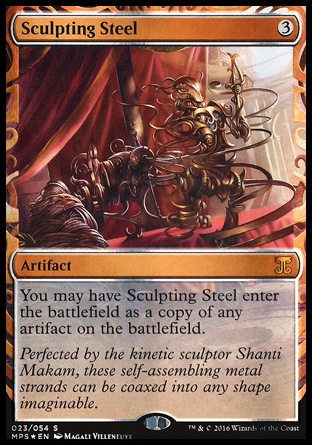


Sculpting Steel enters the battlefield as a copy of Pithing Needle. If Sculpting Steel later becomes a copy of a Meddling Mage, the Mage’s linked ability will have no effect, despite the fact that a card had been named for the physical object as it entered the battlefield.
Give here, take there
Some effects add abilities in the process of copying. Such abilities become copiable values.
Remember the problem from homework for class about abilities: “ Vesuvan Shapeshifter vs Fathom Seer”.
How does Vesuvan Shapeshifter get two abilities? Through copying!
706.3. The copy’s copiable values become the copied information, as modified by the copy’s status (see rule 110.6). Objects that copy the object will use the new copiable values.
Example: Vesuvan Doppelganger reads, "You may have Vesuvan Doppelganger enter the battlefield as a copy of any creature on the battlefield except it doesn’t copy that creature’s color and it gains ’At the beginning of your upkeep, you may have this creature become a copy of target creature except it doesn’t copy that creature’s color. If you do, this creature gains this ability.’" A Vesuvan Doppelganger enters the battlefield as a copy of Runeclaw Bear (a 2/2 green Bear creature with no abilities). Then a Clone enters the battlefield as a copy of the Doppelganger. The Clone is a 2/2 blue Bear named Runeclaw Bear that has the Doppelganger’s upkeep-triggered ability.
706.9a. Some copy effects cause the copy to gain an ability as part of the copying process. This ability becomes part of the copiable values for the copy, along with any other abilities that were copied.
Example: Quirion Elves enters the battlefield and an Unstable Shapeshifter copies it. The copiable values of the Shapeshifter now match those of the Elves, except that the Shapeshifter also has the ability “Whenever a creature enters the battlefield, Unstable Shapeshifter becomes a copy of that creature and gains this ability.” Then a Clone enters the battlefield as a copy of the Unstable Shapeshifter. The Clone copies the new copiable values of the Shapeshifter, including the ability that the Shapeshifter gave itself when it copied the Elves.
When we copy the Seer with the first Vesuvan Shapeshifter, we got a Seer with the Shapeshifter’s ability. Now that set of characteristics is copiable. When the second shifter comes into play, we deal with a new set of copiable values, to which we add the Shifter’s ability again:
706.9b. Some copy effects specifically state that they don’t copy certain characteristics and instead retain their original values. These effects use the phrase “except its [characteristic] is still [value]” or “except it’s still [value(s)].” They may also simply state that certain characteristics are not copied.
706.9c. Some copy effects modify a characteristic as part of the copying process. The final value(s) for that characteristic becomes part of the copiable values for the copy.
706.9d. When applying a copy effect that
- doesn’t copy a certain characteristic,
- retains an original value for a certain characteristic, or
- modifies the final value of a certain characteristic,
any characteristic-defining ability (see rule 604.3) of the object being copied that defines that characteristic is not copied. If that characteristic is color, any color indicator (see rule 204) of that object is also not copied.
Example: Quicksilver Gargantuan is a creature that reads, “You may have Quicksilver Gargantuan enter the battlefield as a copy of any creature on the battlefield, except it’s still 7/7.” Quicksilver Gargantuan enters the battlefield as a copy of Tarmogoyf, , which has a characteristic-defining ability that defines its power and toughness. Quicksilver Gargantuan does not have that ability. It will be 7/7.
“Identify yourself!”
An effect that tracks a permanent by its name will find it even if it becomes something else.
706.11. If an effect refers to a permanent by name, the effect still tracks that permanent even if it changes names or becomes a copy of something else.
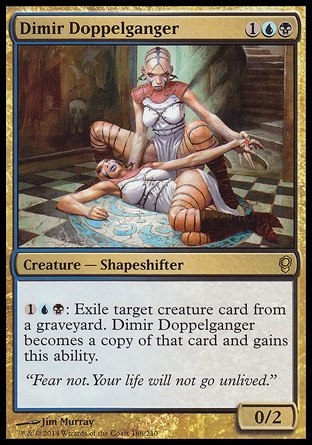

Dimir Doppelganger becomes a copy of a Dragon Whelp. If you activate the ability on the Doppelganger-Whelp more than three times within a turn, you will have to sacrifice the Doppelganger at the end of turn even if it becomes a copy of another creature before that.
Homework
Vesuvan Shapeshifter enters the battlefield, we choose a “twice pumped” Figure of Destiny as the object of copying. What do we get as a result?
The Figure of Destiny's abilities are not those that change copiable values, although they do generate the effect lasting until the end of the game. So, our beloved shapeshifter becomes a normal 1/1 figure with its regular set of abilities.
Phantasmal Image becomes a copy of Geralf's Messenger and… dies. What happens next?
Phantasmal Image is in its primal shape in the graveyard, sure thing, but the triggers going off as creatures leave the battlefield trigger off the battlefield; and while still on the battlefield, Phantasmal Image was a Messenger without counters. Therefore, Undying triggers.
When the trigger resolves, Phantasmal Image returns to the battlefield with a +1/+1 counter. The Shapeshifter still has its ability modifying the way it enters the battlefield, its controller still has the opportunity to choose a creature for the Image to copy.
The most interesting thing happens when Phantasmal Image, being a Messenger without counters, had been "borrowed" from an opponent. Who controls the undying trigger? Who will get the creature under his control?
An opponent attacks you with an animated Treetop Village, you cast Mirrorweave choosing an animated Mutavault as the target. What happens to the village?
Translated by Witas Spasovski

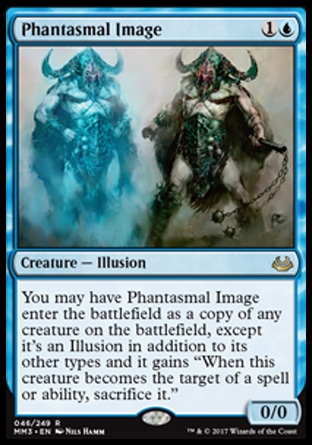
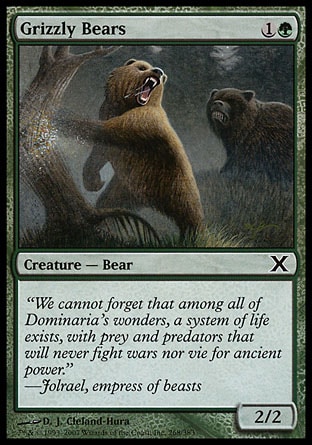
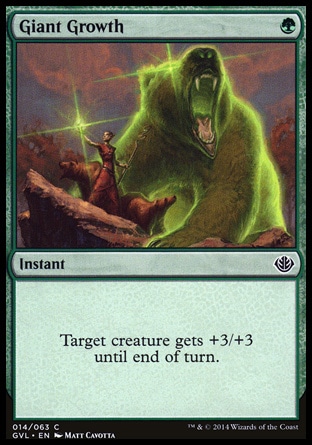

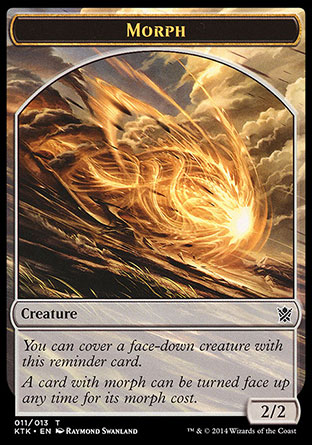
A Grizzly Bears pumped with Giant Growth is copied with Phantasmal Image, what do we get? A 2/2 Bear. Because that’s what’s printed on the card, while the effect of Giant Growth does not affect copiable values. Also, the newly emerged Bear Cub gets another copiable value — Phantasmal Image’s ability “Whenever this creature becomes the target of a spell or ability, sacrifice it”.